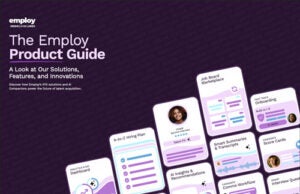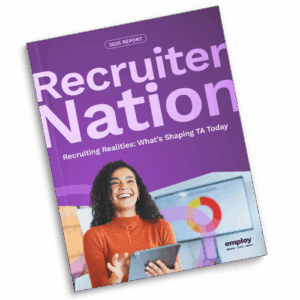Updated: July 2, 2025
If you’re a recruiter, at your core, you’re probably a people person. That means your bread and butter is forging strong relationships with candidates, engaging prospects, and nurturing connections with talent—in other words, managing relationships.
At the same time, there are only so many hours in the day. If you’re relying on traditional methods and legacy applicant tracking systems (ATS) to help you make great hires that stick, you might find yourself struggling to really tap into your talent pool or even losing out on opportunities to engage your candidates, whether they’re active or passive.
Luckily, there are ways to help you give your candidate relationship management (CRM) strategy a boost. Modern tools can help, especially when it comes to spending less time on repetitive tasks and wrangling data, but there’s no replacement for strong strategies that help you connect with candidates, build trust, and engage talent in a way that feels both consistent and personal.
In this post, we’re taking a step-by-step journey through a thoughtful CRM approach. By the end, you’ll understand how focusing on communication and candidate experience can help your talent acquisition (TA) team succeed at your mission. Let’s get started!
What is Candidate Relationship Management?
As you might know, candidate relationship management is the process TA teams use to identify qualified talent, engage them to fill open roles, and maintain long-term connections. When it’s done well, you have a full-cycle recruiting process—a well-oiled machine that drives your hiring effectively and helps you match great candidates with the right opportunities.
It can be tougher to run that full-cycle process if your tools aren’t equipped to help you with tasks like keeping in touch with candidates and taking recurring tasks off your plate.
Why Does Candidate Relationship Management Matter?
The way you approach your CRM strategy doesn’t just impact your immediate hiring efforts. At its strongest, your strategy can also help you:
- Navigate market-level shifts. From economic shifts to global events, external factors can make the job market fluctuate quite a bit. Think of the Great Resignation, when nearly 100 million people left their jobs over the course of two years, or the recent federal sector layoffs that have impacted nearly 65,000 workers (so far). Staying in touch with your candidates helps you build strong relationships and ride the wave of these macro-level changes.
- Nurture a pre-qualified talent pool. When you have an existing talent pool full of candidates who are already aware of and interested in your organization, it’s worth your while to keep them engaged. That way, when a new requisition opens, you don’t need to start recruitment from scratch—a head start that is especially handy when hiring is competitive.
- Deliver a quality first impression for the entire business. This isn’t just common knowledge, it’s an evidence-based approach: Respondents in this year’s Job Seeker Nation Report told us a communicative, timely hiring experience is the best way for a prospective employer to make a good impression.
- Banish fears of ghosting. Candidates crave consistent communication, and they’ve got a good reason. A lack of consistency or long periods of radio silence can fuel fears of being ghosted—something we learned from the 2025 Job Seeker Nation report has happened at least once to almost half of candidates.
- Build sustainable talent pipelines. A proactive CRM strategy nurtures relationships over time, giving you a strong, diverse pool of candidates for when a role opens. This helps you reduce hiring time and avoid scrambling for talent when you’re looking to fill a position quickly.
6 Candidate Relationship Management Strategies for Success
You can’t build a strong, future-proofed CRM strategy without a detailed plan that helps you engage candidates in the recruiting lifecycle.
Keep these best practices in mind as you brainstorm, execute, and iterate on your CRM tactics:
1. Invest in a Recruitment CRM Platform With the Right Capabilities
A simple database to track and store applicants won’t cut it here. You’ll need robust CRM software to help you find, nurture, interview, and hire talent in a streamlined, standardized way.
It’s a little like a Sales or Marketing professional’s approach: Their software helps them send the right messages, to the right prospects, at just the right times in order to close a sale (and save time doing it).
More specifically, you need talent acquisition technology that helps you:
- Automate most (though not all) of your messaging to early-stage prospects
- Receive notifications when candidates engage with your communications
- Move candidates through your recruitment funnel, from first meeting to offer letter
- Make decisions about talent quickly and efficiently
- Organize talent with tags or categories in case you want to revisit them for future roles
- Identify ideal fits for open roles in a matter of seconds
A little research into your must-have features and a few product demos can go a long way to helping you choose a solution to let you recruit and hire with confidence.

2. Communicate With Prospects in a Timely, Personalized Manner
You already know how important communication is when it comes to making a first impression on talent. But there’s more to it than just avoiding radio silence: For example, more than half (57%) of candidates told us they expect to hear back within three days if they’re not selected for a role. This sounds like a high bar to meet, but with the right tech, it doesn’t have to be.
Contacting candidates directly with 1:1 messaging instead of impersonal, generic outreach is the best way to build genuine human connections with them. Your tech can even help you save time while still sending more personalized messages.
Using talent-nurturing tech like Lever expedites communication without compromising personalization with pre-made templates. This helps recruiters:
- Build and test email (and texting!) programs to earn consistently better conversion rates—meaning, how often recipients click through your message and take an action
- Customize communications based on roles and departments
- Adjust your number of touchpoints in each nurture, your schedule for sending them, and the copy you use, so you can improve over time
Remember, the best CRM strategies help you speak with candidates—not at them. Your talent may have questions, concerns, or comments about your hiring process or your company as a whole, so make sure to weave in opportunities for feedback and questions. This strengthens the bond candidates feel with your organization and can help you improve their experience.
3. Keep Talent Engaged Through the Entire Recruitment Lifecycle
Your TA team probably considers multiple prospective hires at any given moment, but that shouldn’t mean a lengthy waiting period for your hiring decision. Many candidates have no shortage of job opportunities, so keep them updated on the status of your hiring process by:
- Setting clear expectations. Build trust by letting candidates know when they can expect to hear back from you, what’s expected of them throughout the process, and other important details.
- Communicating regularly and transparently. Even if the decision-making process takes longer than expected, regular communication protects candidates from feeling neglected or left in the dark about their application status.
- Building long-term relationships. Sometimes, the talent acquisition cycle doesn’t end when a candidate isn’t extended an offer. Adding them to your passive talent outreach stream can help you maintain the connection and potentially fill future job opportunities down the line.
Engaging candidates and standardizing expectations helps you demonstrate that your organization values their time and is committed to a respectful, transparent hiring process. This strengthens your talent acquisition efforts, and it also enhances your employer’s reputation.
4. Balance Active and Passive Candidate Relationship Management
For roles that are hard to fill or situations where you need to hire quickly, one of your best chances of finding qualified talent is to build a pool of passive candidates you know are suited for opportunities like these.
Passive candidates are individuals who aren’t necessarily looking for a job right away, but have shown genuine interest. This kind of candidate could be plentiful, if nurtured correctly—our most recent survey of job seekers told us that even though over 80% were either very or somewhat satisfied with their current job, 85% were open to other opportunities. Try these strategies to reach passive candidates:
- Employee referrals. If you’re not seeing the referral numbers you’d like, take this as a cue to revisit and revamp your referral strategy for stronger employee buy-in. Offer a meaningful incentive, like an extra paid day off, and make sure current staff get notified when a referral they make progresses through the hiring funnel.
- Passive recruitment marketing. Identify where your prospects are likely to spend time online. Then, promote both specific roles and your employer brand to targeted audiences via paid search ads, social media campaigns, and more.
- Attend industry networking events. Unlike career fairs, events like conferences and workshops give talent acquisition pros access to a completely new audience. Even if they’re not actively job hunting, these events provide a chance for your team to engage with potential future hires in a low-pressure setting.
Paying attention to both active and passive prospective hires helps you keep interest in your organization high. Just make sure you’re available to answer passive hires’ questions, since they might be less familiar with you than active prospects.
5. Follow Transparent and Ethical Hiring Practices
A diverse workforce is an innovative one. You can foster an accepting, modern workplace with these intentional steps to mitigate bias and remove barriers:
- Outline the hiring process upfront. Set clear expectations about which materials to submit, how many steps candidates can expect, and other details.
- Share insight into company culture—and stability. Telling candidates about your workplace culture shouldn’t start and end with the monthly lunch-and-learn schedule. Help each candidate see themselves at your organization for the long haul by explaining the overall trajectory of the company, the career path and advancement opportunities for the role, and other useful details.
- Adopt bias-blind hiring practices. Consider removing identifiable aspects of each candidate’s resume, like their name and gender. This can help you avoid the impacts of unconscious bias and improves your odds of selecting candidates based purely on their qualifications.
- Publish accurate job descriptions. When it comes to weeding out poor fits and saving time for both your team and candidates, precise job descriptions beat vague ones every time.
- Embrace structured, behavioral interviews. Making the right hire takes more than just checking off a list of qualifications. In interviews, ask candidates how they’ve handled relevant situations in the past—and let your tools help you offer the same interview experience to each candidate. These practices can put you that much closer to finding a great fit with the experience to succeed.
- Stick to a timeline. If you have to deviate from the outlined hiring timeline, be upfront with applicants, so they aren’t left on the hook.
Treating your candidates with candor and respect has both short- and long-term benefits for everyone: it increases the likelihood that they’ll sign on to work with your company and stay loyal over time.
6. Let Your Data Improve Improve the Candidate Experience
You can use the data you already gather to enhance the experience you offer each candidate. Here’s how your CRM software can help:
- Leverage reporting and data collection features.
- Track relevant KPIs—for example, check your candidate satisfaction score, application completion rate, time to fill, offer acceptance rate, and drop-off rate.
- Analyze quantitative feedback via surveys and exit interviews.
- Forecast which changes will be effective, and use those predictions to set SMART goals.
These strategies have one element in common: They hinge on your team using a powerful CRM system. Pairing your chosen system with data hygiene best practices, like regular audits and standardized formatting, helps you offer a seamless, data-driven candidate experience. And that supports your ultimate goal: Making great hires.
Every recruiter wants to create a more positive and efficient hiring process, but it can be tough to meet that goal with limited time and resources. When your tech can help you structure your communication, collect and act on candidate feedback, and continuously keep in touch with qualified talent, your CRM strategy can help you take every opportunity to build strong candidate relationships that go the distance.
Learn more about how Lever can help you meet your CRM goals.
















